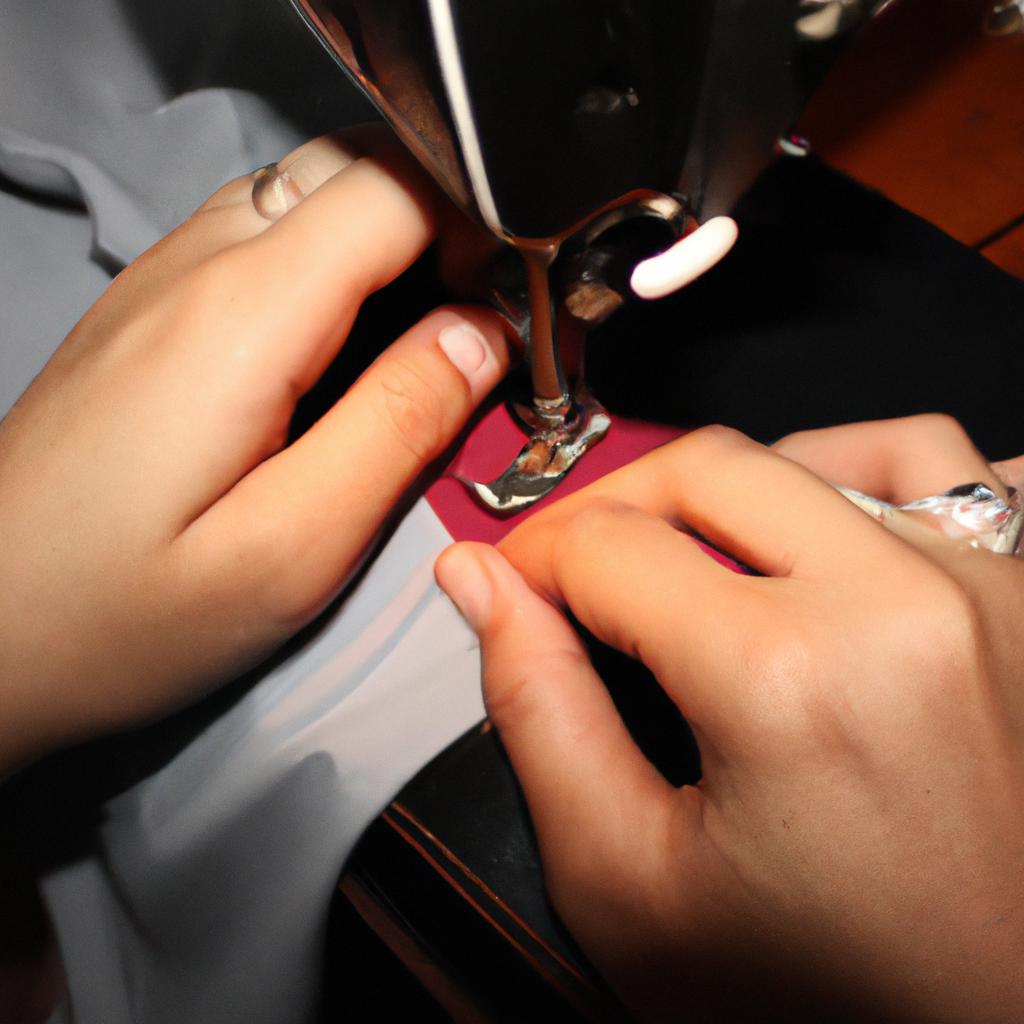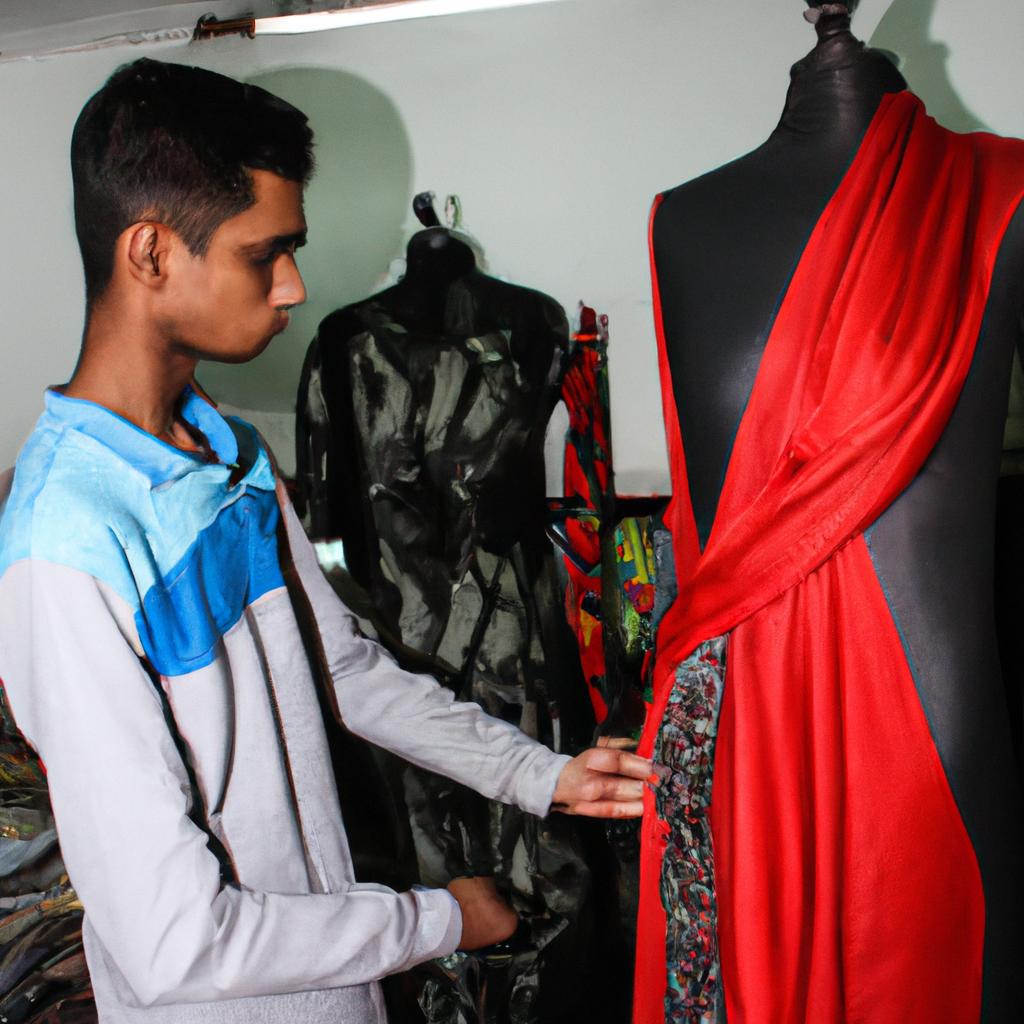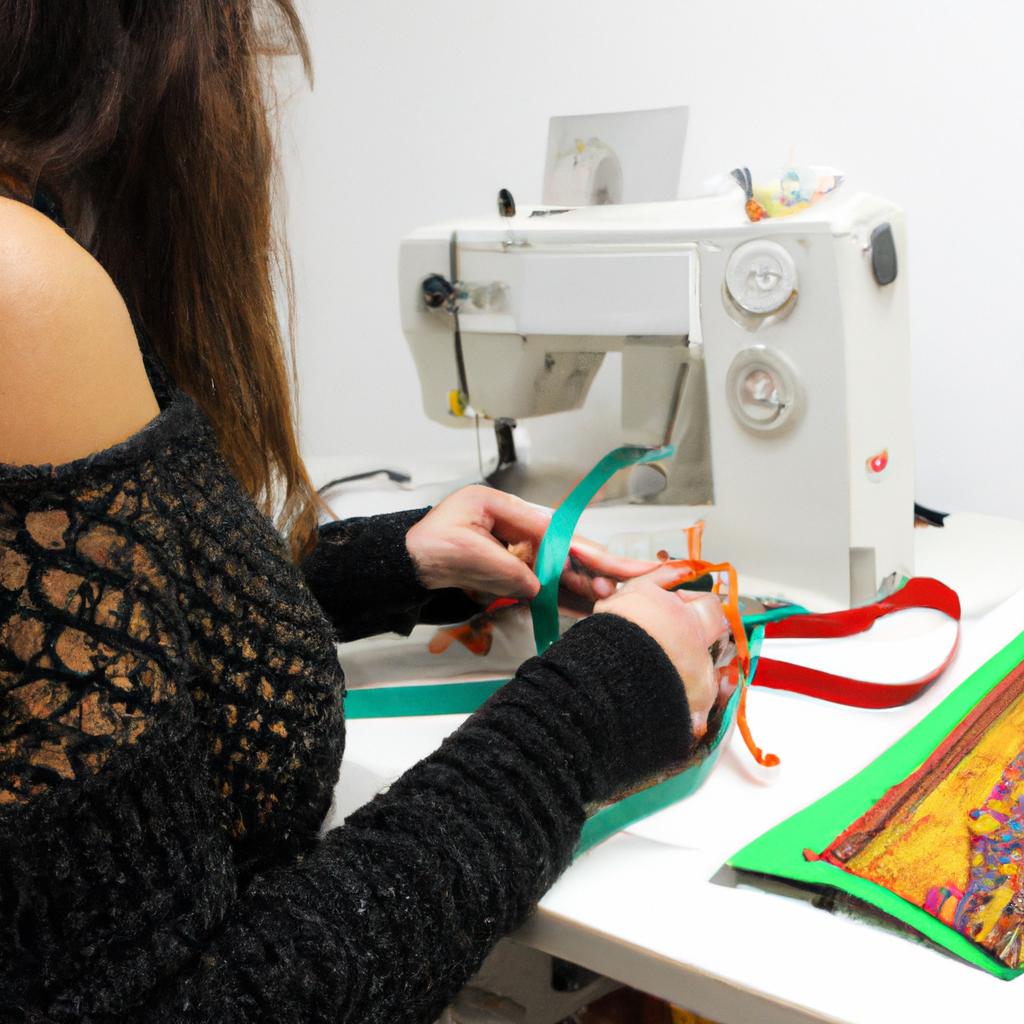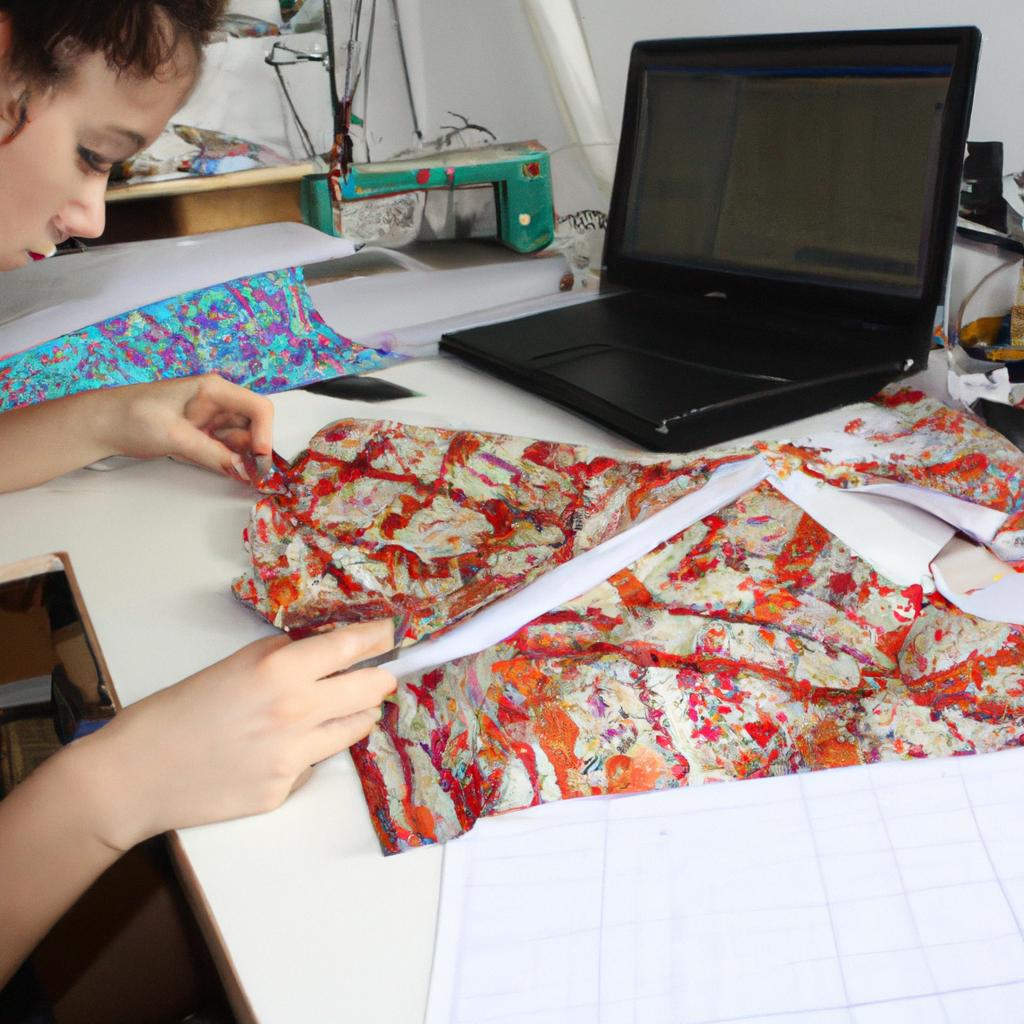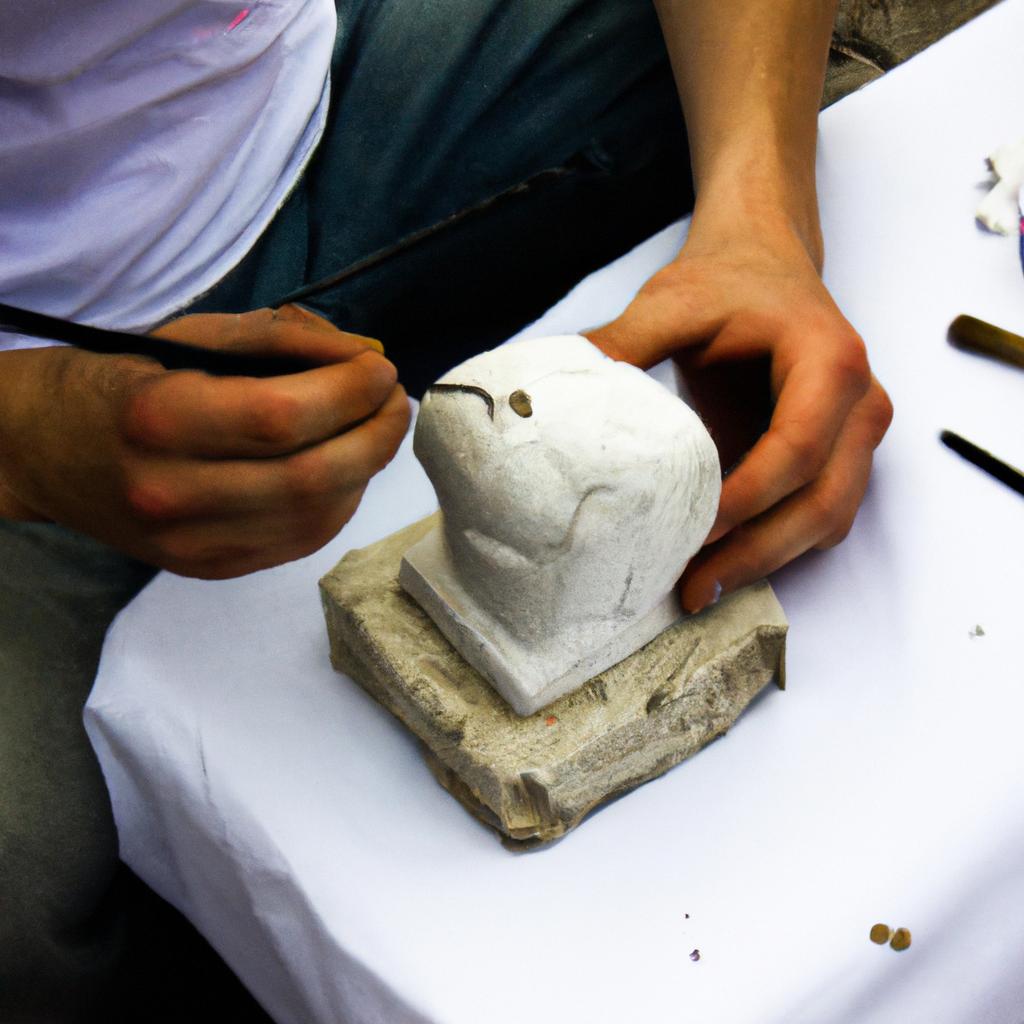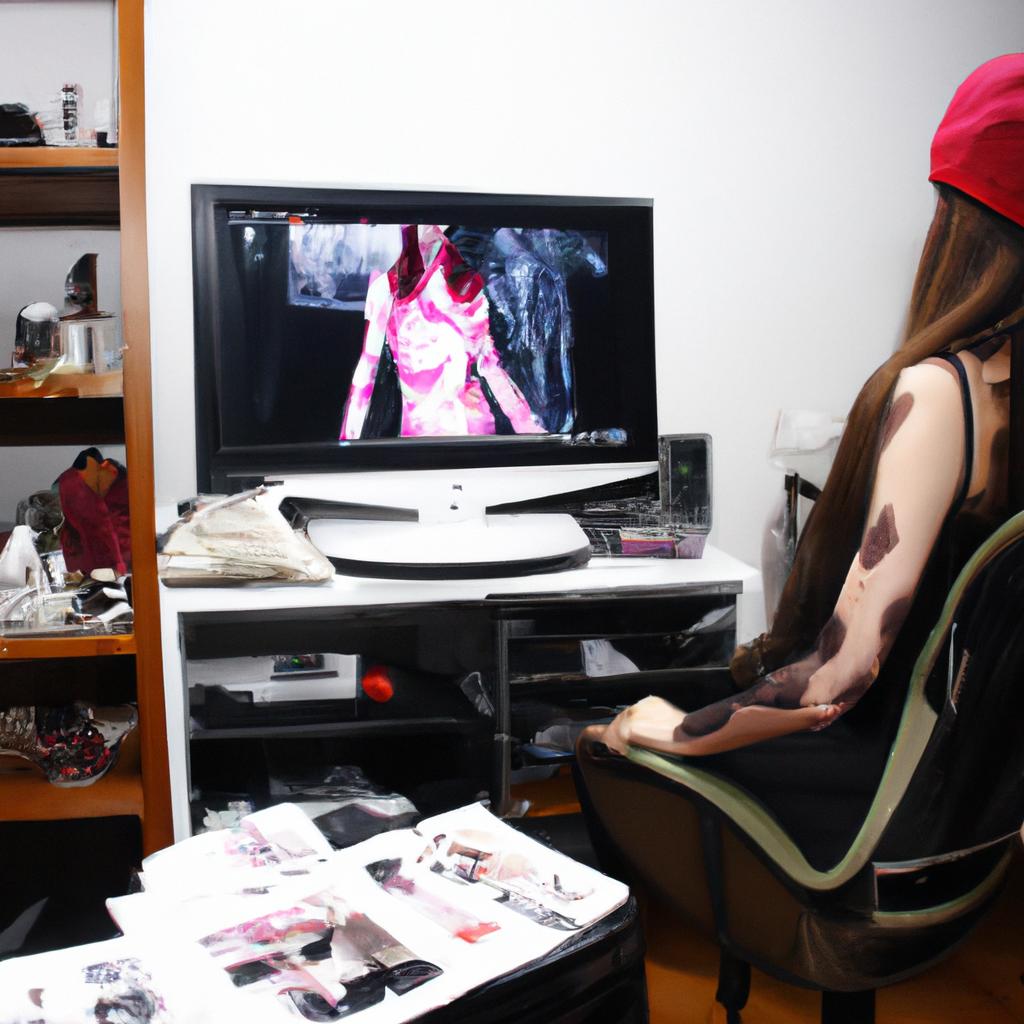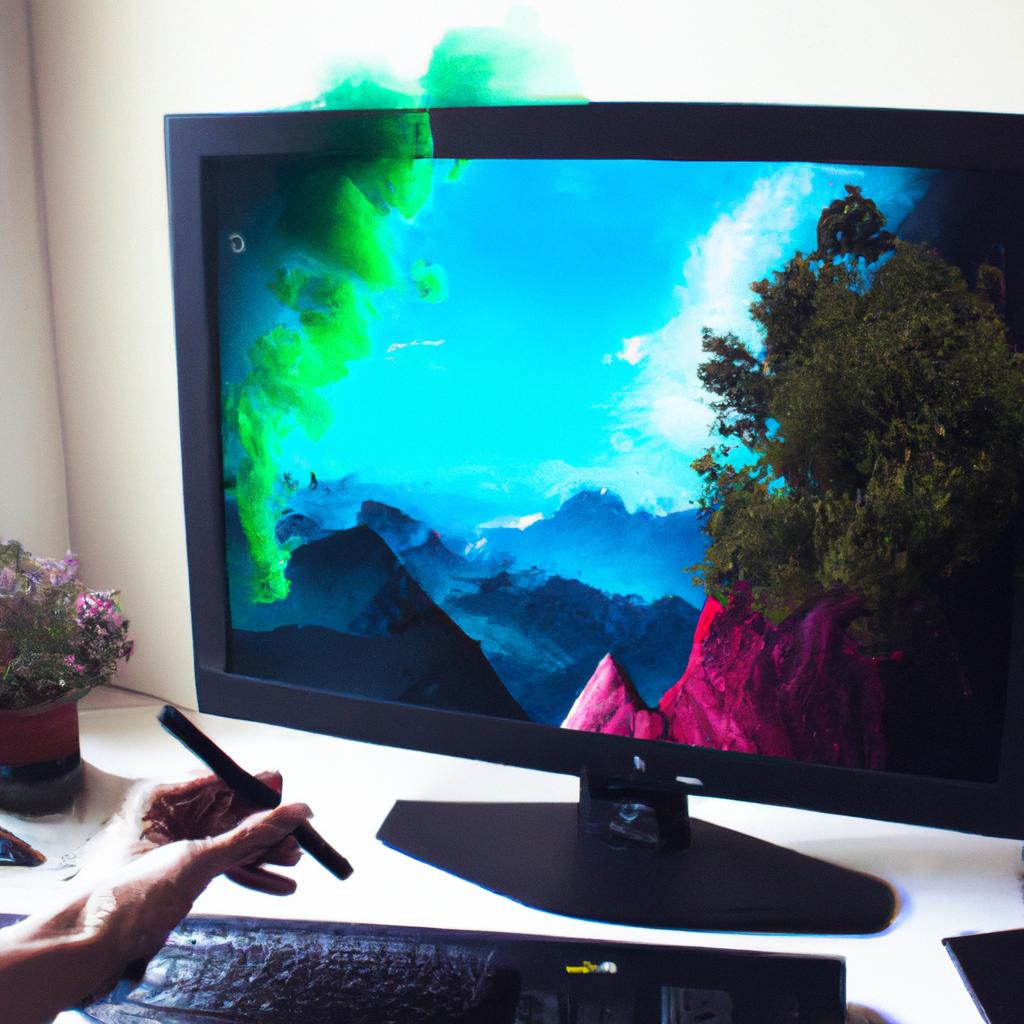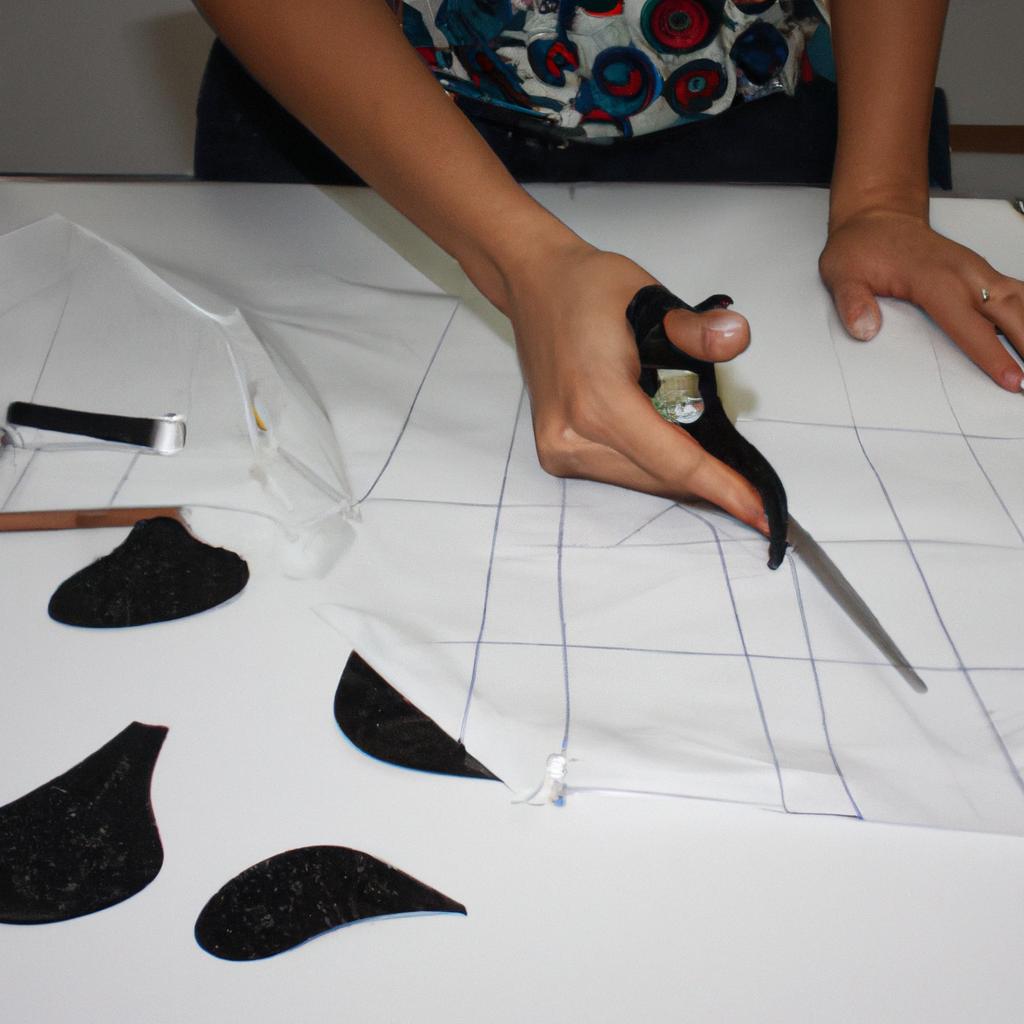Garment construction plays a crucial role in the world of arts and television, as it serves as the foundation for creating captivating costumes and visually compelling designs. Whether it be designing period-specific clothing for historical dramas or crafting elaborate ensembles for fantasy series, understanding the intricacies of fashion design is essential for bringing characters to life on screen. For instance, consider a hypothetical scenario where an upcoming television show centers around a group of time-traveling adventurers. The success of this fictional production would heavily rely on the accuracy and attention to detail exhibited in their costumes, highlighting the importance of garment construction in capturing the essence of different eras.
In this article, we aim to provide an informative guide to fashion design within the context of arts and television. We will explore various aspects such as fabric selection, pattern drafting techniques, fitting considerations, and finishing touches that contribute to successfully constructing garments for artistic purposes. By delving into these topics with an academic approach, we hope to equip aspiring designers and enthusiasts alike with valuable knowledge about garment construction’s vital role in creating visually stunning pieces that enhance storytelling through costume design. Understanding how intricate details can transform ordinary fabrics into extraordinary creations not only enhances our appreciation for artistry but also deepens our understanding of how costume design contributes to character development and narrative storytelling.
The process of garment construction begins with fabric selection, which plays a crucial role in capturing the essence of different eras or fictional worlds. Depending on the desired look and feel, designers may choose fabrics that are historically accurate or ones that evoke a specific mood or aesthetic. For example, a period drama set in the Victorian era would require fabrics such as silk, brocade, and lace to recreate the opulence and intricacy of that time period. On the other hand, a futuristic sci-fi series might call for avant-garde materials like metallics, neoprene, or even 3D-printed textiles to convey a sense of innovation and technological advancement.
Once the fabrics have been chosen, pattern drafting techniques come into play. Designers use their knowledge of body measurements and proportions to create paper patterns that will serve as blueprints for cutting out fabric pieces. Accuracy is key here since any missteps at this stage can result in ill-fitting garments. Pattern-making involves taking into account factors like ease (the amount of room needed for comfortable movement), drape (how the fabric falls on the body), and style lines (the shape and structure of the design). By mastering these techniques, designers can ensure that their creations not only look visually appealing but also fit well on the actors who will be wearing them.
Fitting considerations are another important aspect of garment construction in television and arts. Costume designers work closely with actors to ensure that their costumes fit properly and allow for mobility while still maintaining the desired aesthetic. This often involves multiple fittings where adjustments are made based on feedback from both the designer and actor. Attention to detail is crucial during these fittings as even small alterations can greatly impact how a costume looks on screen.
Finally, finishing touches complete the garment construction process. These include details such as closures (zippers, buttons, hooks), trims (lace, ribbons), embellishments (beading, embroidery), and any necessary alterations or adjustments. These elements add depth and character to the costumes, elevating them from simple garments to visually compelling works of art.
In conclusion, garment construction plays a vital role in the world of arts and television by bringing characters to life through costume design. From fabric selection to pattern drafting techniques, fitting considerations, and finishing touches, each step contributes to creating visually stunning pieces that enhance storytelling and contribute to character development. By understanding the intricacies of fashion design within this context, aspiring designers and enthusiasts can gain valuable knowledge about how clothes can transform an ordinary script into an extraordinary visual experience on screen.
Historical influences on garment construction in arts and television
One example that highlights the historical influences on garment construction in arts and television is the iconic fashion designs of Coco Chanel. Born in 1883, Chanel revolutionized women’s fashion by challenging traditional corsets and introducing more comfortable yet elegant clothing options. Her famous little black dress, a versatile piece still popular today, exemplifies her innovative approach to garment construction. This case study serves as an illustration of how historical factors can shape the evolution of clothing design for artistic and televised purposes.
The development of garment construction techniques has been greatly influenced by various historical periods and cultural movements. These influences are evident not only in the materials used but also in the overall structure, silhouette, and embellishments incorporated into garments. For instance:
- Renaissance era: The emphasis on opulence and grandeur during this period led to the use of rich fabrics like velvet, elaborate embroidery, and intricate lacework.
- Art Nouveau movement: Characterized by flowing lines inspired by nature, Art Nouveau impacted garment construction through draping techniques that created soft, organic silhouettes.
- Bauhaus movement: With its focus on functionality and minimalism, Bauhaus influenced garment construction by emphasizing clean lines and geometric shapes.
- Postmodernism: This movement challenged conventional ideas about fashion, resulting in unconventional cuts, asymmetrical designs, and experimental combinations of materials.
To evoke an emotional response from readers regarding these historical influences on garment construction in arts and television:
- Historical influences have given birth to timeless styles cherished even today.
- The craftsmanship involved in creating garments reflects the dedication of those who contribute to their creation.
- Garments carry stories from different eras that connect individuals with their past.
- Exploring historical influences allows us to appreciate fashion as an art form intertwined with culture.
| Historical Era | Influences on Garment Construction |
|---|---|
| Renaissance | Opulent fabrics, elaborate embroidery, intricate lacework |
| Art Nouveau | Draping techniques, organic silhouettes |
| Bauhaus | Clean lines, geometric shapes |
| Postmodernism | Unconventional cuts, experimental materials |
Understanding the historical influences on garment construction in arts and television allows designers to draw inspiration from the past while creating contemporary pieces. In the subsequent section about “Techniques and tools for creating garments in arts and television,” we will delve into the practical aspects of bringing these designs to life. By exploring both historical influences and modern practices, fashion designers can develop a comprehensive understanding of how to construct garments that resonate with artistic expression on screen or stage.
Techniques and tools for creating garments in arts and television
Building upon the historical influences on garment construction in arts and television, it is essential to explore the techniques and tools employed in the creation of these visually captivating pieces. One notable example that showcases the intricacy involved in this process is the iconic costume design for Daenerys Targaryen in the television series Game of Thrones. The skilled artisans behind her wardrobe utilized a combination of traditional hand-sewing methods and modern technology to bring this character’s elaborate costumes to life.
To achieve such remarkable results, fashion designers working in arts and television employ various techniques that allow them to create unique and aesthetically pleasing garments. These techniques include:
-
Draping: This method involves manipulating fabric directly on a dress form or model, allowing designers to visualize how the garment will fall on different body shapes. By draping fabric, they can experiment with silhouette, fit, and overall design before proceeding with pattern making.
-
Pattern Making: Patterns are templates used as a guide when cutting out fabric pieces for assembly. Fashion designers use their knowledge of human anatomy and garment construction principles to draft patterns that ensure proper fit and functionality.
-
Tailoring: Tailoring refers to the art of fitting garments precisely to an individual’s measurements, resulting in a flattering silhouette. It involves intricate stitching techniques like darts, pleats, gathers, and seams that enhance both comfort and aesthetic appeal.
-
Embellishment Techniques: Decorative elements play a crucial role in enhancing the visual impact of garments created for arts and television. Embroidery, beading, appliqué work, sequins, or even digital printing techniques are employed to add texture, depth, and detail to designs.
| Technique | Description |
|---|---|
| Draping | Manipulating fabric directly on a dress form or model |
| Pattern Making | Creating templates for cutting out fabric pieces based on design specifications |
| Tailoring | Precisely fitting garments to individual measurements through skilled stitching techniques |
| Embellishment | Adding decorative elements such as embroidery, beading, or digital printing to enhance the visual appeal and texture of the garment |
These techniques, combined with specialized tools like dress forms, sewing machines, sergers, and pressing equipment, enable fashion designers in arts and television to bring their creative visions to life. By employing a combination of traditional craftsmanship and innovative technology, they can create garments that not only meet the demands of artistic expression but also fulfill the practical requirements necessary for on-screen performances.
Understanding these techniques and tools is crucial; however, equally significant in the realm of garment construction for arts and television is the careful selection of fabrics. Let us now delve into the importance of fabric choice in creating visually captivating costumes for screen adaptations.
Importance of fabric selection in garment construction for arts and television
Garment Construction in Arts and Television: An Informative Guide to Fashion Design
Section H2: Techniques and tools for creating garments in arts and television
Section H2 (continued): Importance of fabric selection in garment construction for arts and television
The careful choice of fabrics plays a crucial role in bringing a character’s costume to life on screen or stage. To illustrate this point, let us consider the case of a period drama set in the 19th century.
Paragraph 1:
In this hypothetical scenario, where historical accuracy is paramount, selecting appropriate fabrics becomes even more critical. Different characters may require unique costumes based on their social status or occupation. For instance, an upper-class gentleman would typically wear clothing made from high-quality materials such as silk or fine wool, while a working-class servant might be dressed in sturdier cotton or linen garments. By choosing suitable fabrics that align with the characters’ roles and backgrounds, costume designers can enhance authenticity and help actors embody their roles convincingly.
Paragraph 2:
When making fabric selections for arts and television productions, several factors need to be considered beyond just historical accuracy. These include practicality, durability, comfort for the performers, visual appeal under various lighting conditions, and ease of maintenance during long shooting schedules. To guide these decisions effectively, here are some key considerations:
- Fabric weight: Choosing lightweight fabrics allows for freedom of movement on camera.
- Colorfastness: Opting for colorfast materials ensures that costumes retain their intended colors throughout filming.
- Texture: Selecting textured fabrics adds depth and interest to costumes both visually and tactically.
- Draping qualities: Fabrics should drape well on different body types to create flattering silhouettes.
These considerations not only contribute to the overall aesthetic appeal of costumes but also help create a comfortable and visually captivating experience for the audience:
- The right choice of fabric can transport viewers into different time periods or fictional worlds, evoking a sense of immersion.
- Well-chosen fabrics enhance the actors’ performances by allowing them to move naturally and express their characters more convincingly.
- Attention to detail in fabric selection demonstrates the dedication and professionalism of costume designers, fostering admiration from both industry professionals and audiences alike.
- Ultimately, carefully selected fabrics contribute to the overall quality of arts and television productions, elevating the viewer’s emotional connection with the story.
Paragraph 3:
By understanding these considerations, garment construction in arts and television can be elevated to new heights. Fabric selection serves as an essential tool for costume designers to breathe life into characters on screen or stage. In the subsequent section about creating costumes for characters in arts and television productions, we will explore further steps that contribute to achieving the desired visual impact while adhering to budgetary constraints and artistic visions.
Creating costumes for characters in arts and television productions
Garment construction plays a crucial role in the creation of costumes for characters in arts and television productions. With careful attention to detail, fashion designers can bring these characters to life through their clothing choices. By understanding the needs of each character and considering factors such as body type, personality traits, and historical context, designers can create costumes that not only enhance the visual appeal but also contribute to the overall storytelling.
For instance, let’s consider the popular television show “Game of Thrones.” The elaborate costumes worn by characters like Daenerys Targaryen and Cersei Lannister not only reflect their individual personalities but also convey important aspects of their respective storylines. Through fabric selection, garment construction techniques, and intricate embellishments, the costume designers were able to transport viewers into a world filled with fantasy while maintaining an air of authenticity.
When creating costumes for arts and television productions, there are several key considerations that garment construction must address:
- Character portrayal: Costumes should accurately represent the characters’ roles in terms of status, occupation, or time period.
- Practicality: Garments need to be functional for actors during performances without hindering movement or causing discomfort.
- Durability: Given the rigorous demands of production schedules, garments must withstand frequent wear and tear.
- Visual impact: Costumes should capture attention on-screen by incorporating elements such as color palettes, textures, and silhouettes that highlight key character attributes.
To illustrate this further, consider the following table showcasing how different design elements can evoke specific emotional responses from audiences when properly incorporated into garment construction:
| Design Element | Emotional Response |
|---|---|
| Bold colors | Excitement |
| Delicate fabrics | Elegance |
| Intricate details | Fascination |
| Draped silhouettes | Mystery |
By carefully selecting fabrics and employing various garment construction techniques such as draping or tailoring, designers have the power to evoke specific emotions in viewers. This emotional connection between the audience and the characters is vital for effective storytelling in arts and television.
In the subsequent section about “The role of garment construction in enhancing storytelling in arts and television,” we will explore how these costumes contribute to character development, narrative progression, and overall visual aesthetics without relying solely on dialogue or plot devices. Through a detailed examination of notable examples from various productions, we will delve deeper into understanding the impact of garment construction as an integral part of storytelling.
The role of garment construction in enhancing storytelling in arts and television
Creating costumes for characters in arts and television productions requires meticulous attention to detail and a deep understanding of garment construction. By carefully crafting each piece, costume designers bring characters to life and enhance the overall storytelling experience. This section will explore the crucial role of garment construction in enhancing storytelling in arts and television, using examples from well-known productions.
One notable example is the hit TV series “Game of Thrones,” where elaborate costumes play a pivotal role in portraying the different houses and characters. The Stark family’s signature fur cloaks evoke a sense of ruggedness and resilience, while Cersei Lannister’s regal gowns emphasize her power and influence. These costumes not only reflect individual character traits but also contribute to the audience’s immersion in the fictional world.
Garment construction serves as a powerful tool for visual storytelling by conveying meaning through various elements such as fabric choice, silhouette, color palette, and embellishments. Here are some key ways in which it enhances the narrative:
- Establishing time period: Historical dramas like “The Crown” rely on accurate period costumes to transport viewers back in time.
- Communicating social status: In shows like “Downton Abbey,” variations in garments signify class distinctions among characters.
- Reflecting character development: Changes in a character’s wardrobe can symbolize personal growth or transformation throughout a series or film.
- Creating symbolic associations: Certain garments may be used as symbols or motifs that represent themes or concepts within the story.
To further illustrate this point, consider the following table showcasing how garment construction techniques were utilized to reinforce storytelling elements in popular productions:
| Production | Storytelling Element | Garment Construction Technique |
|---|---|---|
| “Mad Men” | 1960s societal norms | Structured silhouettes |
| “Stranger Things” | Nostalgia | Retro-inspired prints |
| “The Handmaid’s Tale” | Oppression | Red color symbolism |
| “Black Mirror” | Technological dystopia | Futuristic materials and textures |
Through such deliberate choices in garment construction, costume designers contribute to the overall narrative by visually immersing audiences into the story’s world.
Moving forward, we will explore the challenges and current trends that shape garment construction for arts and television productions. Understanding these dynamics is crucial for costume designers seeking to stay ahead in this dynamic field of creativity and storytelling.
Challenges and trends in garment construction for arts and television
The role of garment construction in enhancing storytelling in arts and television cannot be understated. Each detail, stitch, and fabric choice contributes to the overall narrative portrayed on screen or stage. By carefully constructing garments that align with a character’s personality, background, and storyline, costume designers play a crucial part in bringing characters to life.
One example that highlights the impact of garment construction is the popular TV show “Game of Thrones.” The intricate costumes worn by each character not only reflect their social status but also convey important information about their alliances, motivations, and journeys throughout the series. From Daenerys Targaryen’s regal gowns symbolizing her claim to the throne to Jon Snow’s rugged fur coats representing his connection to the North, every costume choice adds depth and complexity to these characters’ stories.
To effectively fulfill their role in enhancing storytelling through garment construction for arts and television, costume designers face several challenges while keeping up with current trends. These challenges include:
- Time constraints: Costume designers often have limited timeframes to create complex designs that meet production deadlines.
- Budget limitations: Working within budgetary restrictions can pose difficulties when trying to achieve desired aesthetics without compromising quality.
- Authenticity: Ensuring historical accuracy or accurately portraying specific cultures requires extensive research and attention to detail.
- Collaboration: Costume designers must collaborate closely with directors, producers, actors, and other members of the creative team to ensure cohesive storytelling.
| Challenges | Trends | Solutions |
|---|---|---|
| Time constraints | Sustainable fashion | Efficient workflow |
| Budget limitations | Gender fluid clothing | Resourcefulness |
| Authenticity | Upcycling materials | Extensive research |
| Collaboration | Inclusivity and diversity | Effective communication |
Overcoming these challenges while staying true to artistic vision allows costume designers to create visually stunning garments that enhance the storytelling experience for viewers. With each stitch and fabric choice, they bring characters to life and contribute to the overall narrative of arts and television productions.
In conclusion, the role of garment construction in enhancing storytelling in arts and television is a vital aspect that cannot be overlooked. Through careful attention to detail, costume designers create garments that reflect character personalities, backgrounds, and storylines. Despite challenges such as time constraints and budget limitations, these professionals continue to push boundaries by incorporating current trends while maintaining authenticity. By doing so, they contribute significantly to the immersive nature of visual storytelling on screen or stage.

